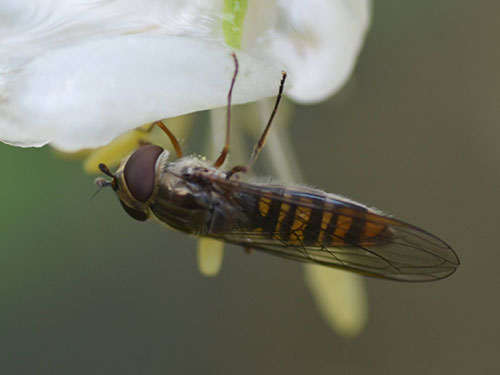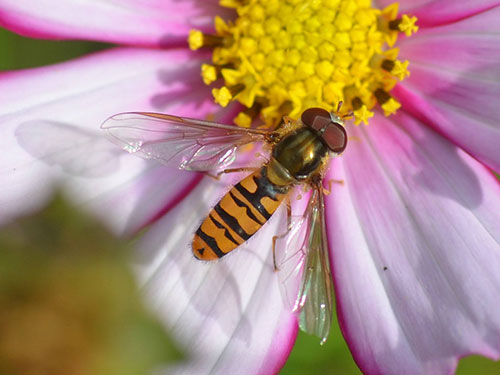


A female Marmalde Hoverfly visiting Winter Flowering Honeysuckle in January
Photo: Becky Walton

A male Marmalade Hoverfly in summer
Photo: Becky Walton
The next time you’re spreading some marmalade on your toast on a crisp winter’s day, give a thought to a pollinator that might be out visiting flowers in your garden or local green space – the Marmalade Hoverfly (Episyrphus balteatus). This attractive fly (and our commonest hoverfly) is so named for the alternating thick and thin lines on its abdomen (thick cut and thin cut, get it?), the thin ones often looking just like little moustaches. No other hoverfly has this patterning so it's a really easy species to identify. But be aware before you go out searching for them that the background colour is highly variable, something that is influenced by the temperature at which the larvae develop: larvae that develop in hotter conditions are more orangey, whereas those that start life in colder conditions have a much darker colour, sometimes almost black, with the abdominal bands often appearing paler. Like many hoverflies (though not all) male and female Marmalade Hoverflies can be readily told apart by their eyes: those of the male join together while the female's are separated.
Marmalade hoverflies hibernate in winter but will be drawn out on warmer days to feed on plants like Winter Flowering Honeysuckle (Lonicera fragrantissima). At the height of summer, our resident population is bolstered by a mass immigration of cousins from the continent, often leading to the ‘wasp invasion’ media madness that insect lovers have had to become used to. It is possible to count hundreds of individuals on a single day.
For anyone who is interested in recording ‘Marmalades’ and any of the other 270(ish) UK hoverflies, there is excellent information and support available through the long-established Hoverfly Recording Scheme and please put any sightings on iRecord. But be careful – much as tea is the ‘gateway drug’ to biscuits, hoverflies are known to be the gateway drug to the enormous order they form part of: the Diptera, or ‘true flies’. With around 7,000 species in the UK, you might find yourself busy!
Every month it is our aim to highlight a species that is “in-season” and, although not necessarily rare or difficult to identify, has been highlighted by our local recording groups as being somewhat under-recorded and for which new records would therefore be welcomed.
If you or your recording group are aware of species such as this then please contact Bob Foreman.